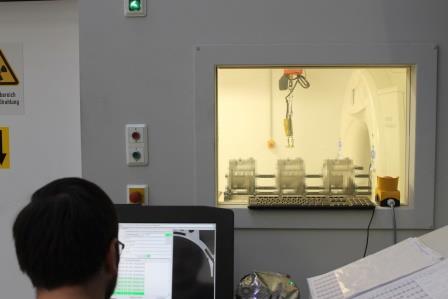AI improves competitiveness

Microvista GmbH has specialised in industrial computer tomography, one of the most modern non-destructive measuring and test processes, and is among the leading service companies in Germany in this area.
Most people in medical diagnostics are familiar with computer tomographs (CTs). CTs serve, for example, in cardiology, orthopaedics, oncology and many other disciplines to obtain three-dimensional images of the body’s interior. In the last three decades, technical progress has led to decreased radiation exposure for patients due to reduced examination times. Industrial component testing can now also benefit from these developments. CTs are used, for instance, for the non-destructive testing primarily of objects made of light metal and fibre composites, including in the aviation and space travel industry as well as in automotive construction and plant engineering. “While approximately a decade ago, scanning a vehicle cylinder head took six to eight hours, now it can be done in about 30 seconds,” says Dr Lutz Hagner, Managing Director of Microvista in Blankenburg.
However, more speed in the CT scan is only part of the solution for a fast and thus cost-effective inspection of components. Ultimately, the 3D image information generated by the tomograph must subsequently also be evaluated. This process is time-consuming and requires expert knowledge. Only rarely can a test report be completed in less than half an hour. The evaluation of CT data thus becomes a bottleneck in the inspection process. Evaluating the CT data of large quantities of components would take several weeks and would therefore not be economically sensible.
The route to overcoming this bottleneck is opened up by artificial intelligence, which the company from Saxony-Anhalt uses for the analyses. In a multi-stage process, the CT measurement data is compared with the quality criteria specified by the AI. Anything suspicious is analysed again in a further step using traditionally developed software from Microvista according to the parameters specified therein. Compared to the previous quality inspection, which focuses on checks limited to samples, with the support of artificial intelligence the CT inspection allows competitive advantages. With it, manufacturing processes can be further optimised with regard to material and time expenditure. Thanks to this innovation, Microvista is one of the hidden heroes of the economy in Saxony-Anhalt. Thanks to AI, the Blankenburg-based company, which has existed for only ten years, has gained a competitive advantage and has received customer orders from a large number of European countries. “We test individual parts as well as series of up to 20,000 parts and more,” says Managing Director Dr Hagner. Additionally, the Microvista employees have already analysed hundreds of completely assembled car engines with their computer tomographs.
Whiel in previous years most test orders came from the classic automotive industry with combustion engines, recently it has increasingly been companies and suppliers that produce components for the electromobility sector. “Currently, no-one can predict how permanent this demand will be,” says the Microvista Managing Director. He sees in it a catch-up trend that follows the current developments in the automotive market.
“It is very important to us to keep an eye on electromobility and to tap into new customer groups in good time,” says Dr Hagner. Mirovista was founded in 2008 with financial support from the state of Saxony-Anhalt, the Mittelständische Beteiligungsgesellschaft and the regional savings bank in Blankenburg. After about four years, it found itself in the black again for the first time.
Unlike many an industrial company in Germany, the Harz firm has no problem when it comes to looking for employees. “Our increasing amount of young talent comes mainly from our region,” says Dr. Hagner. These are mainly graduates of Harz University of Applied Sciences in Wernigerode and the University of Magdeburg. “We offer our staff an interesting job characterised by variety and innovative renovation. Fun on the job is also ensured by the heavily team-orientated working method with a flat hierarchy and a corporate culture that the employees play a large part in determining.”
Author: Uwe Seidenfaden
